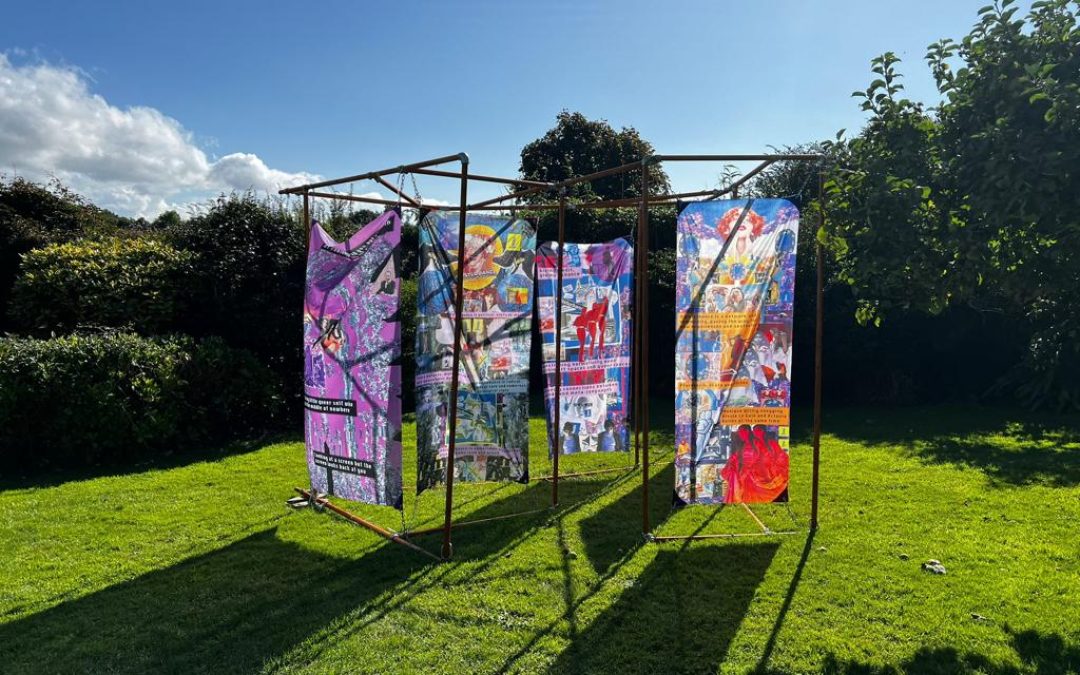Part two of a two-part series on KALLIDA festival by Morena Alano, including interviews with the festival’s installation artists. Connect with Morena via Instagram.
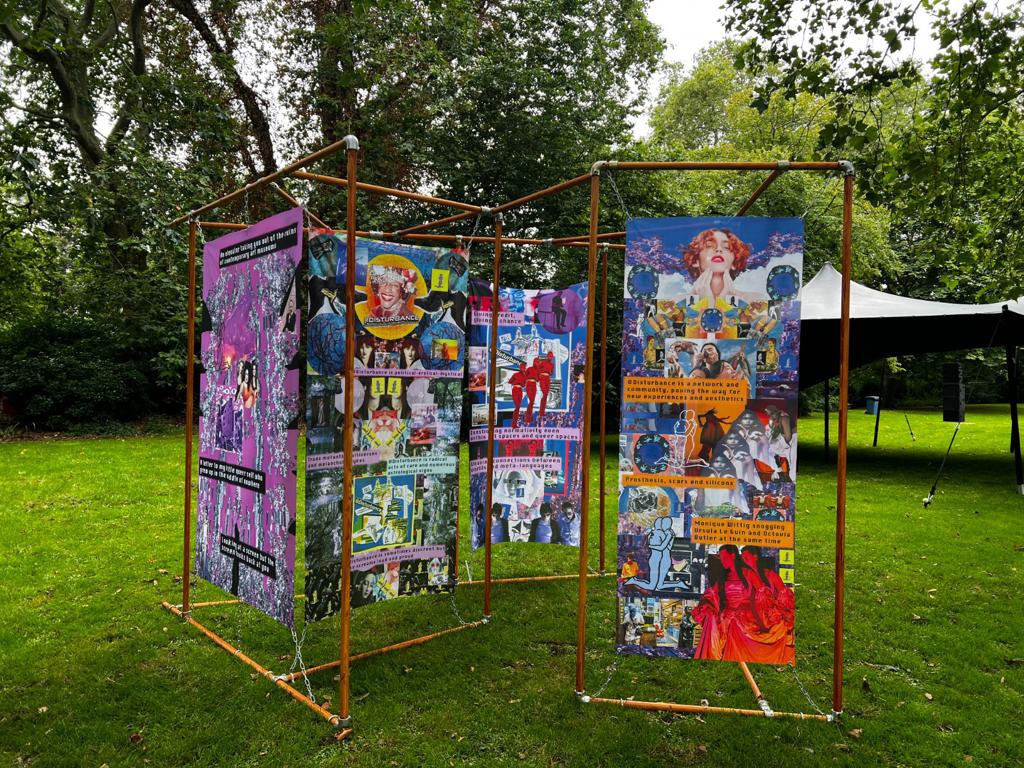
I’m not sure if it’s just me or if everyone follows the same process, but as soon as I get to a festival I’m hit with the urge to explore the venue to understand my way around as quickly and early as possible, or perhaps to allow for my intoxicated mind to find its way back to my tent in the early hours of the morning. It’s like a human instinct of survival—where are the toilets, bars, stages? Who’s playing where and when, where can I retreat for a breather after 6 hours on my feet… and, the main question on my mind—what sort of art will I encounter? As a festival which puts as much of a focus into the overall immersive experience as Kallida, the visual side is a key aspect of what makes the festival so unique—my job was to explore it.
“As much as the sound and music is at the forefront at Kallida, so are the aesthetics.”
Fiona
It was my first time attending Kallida, and quite a spontaneous decision at that, but I couldn’t help myself and had to dig a little deeper. However the website and socials gave little to explore and left a lot to the imagination, so I couldn’t wait to get to the secret spot in North East Devon and discover what awaited us. I’m not going to lie—the arrival was rainy, windy and cold (not exactly what I had envisioned from the sunny videos and photos). After collecting our bracelets we quickly and clumsily set up our tent, which was wet within seconds… oh UK, how we love you. At this point I’m wondering why the hell 24 hours ago I decided to come to this impromptu adventure, when I could be dry and comfortable at home or my local pub. But we’re here, so let’s get moving. The first thing we spot, is a colourful block of colours moving ever so slightly with the wind, but bringing the greenery alive with its industrially bright colours. In many ways it mimics the colour combination in the main stage, built by artist Reg Manning, but in a way more organic and interpretative. Where the main stage is very geometric and uses primary colours, Freddy’s installation plays on shapes, textures and bright tones to illustrate the festival across the year since its inception, weaving together the music, art, and energy.
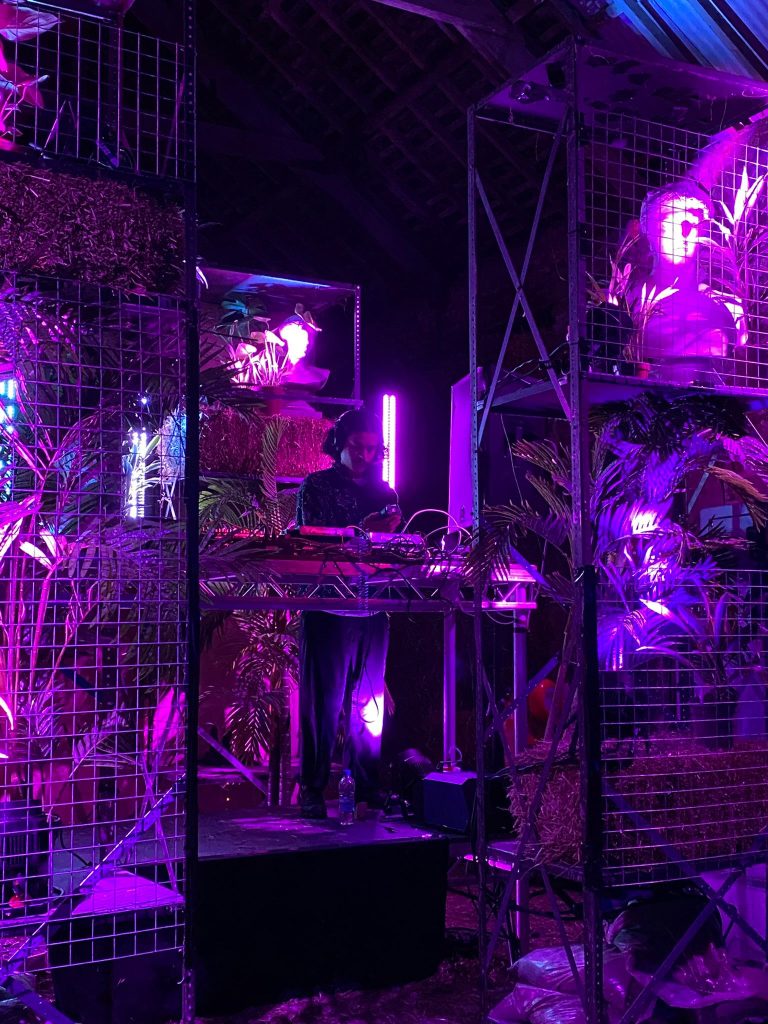
As we continue our exploration, the rain starts to get heavier and we quickly take shelter in the barn by the toilets and head towards a mysterious door. Here, we discover a person peacefully seated in the entrance who calmly looks up at us and invites us into their installation. It seemed as if they were almost oblivious to the storm happening inches from their feet. And in we go, why not? I’m honestly not sure where I’m standing. To set the scene, the place looks like a DIY hospital operation room with a splash of spider webs and Wisteria / Honeysuckle creeping in from all sides. The calm human introduces themself as Zaron Mismeras and kindly asks for a volunteer for the interactive piece, to which I automatically offer myself as tribute (how can I not?!). I am asked to lay on my back and place my head between the red and blue light. They place an intimidatingly large pair of noise cancelling headphones over my face and stick two sensors on my hands that will read my stress levels and produce noise and light waves accordingly for a full 5 minutes, but I was too nervous and excited to understand that at the time.
To begin with, the experience felt like 1 minute not 5, and without sounding too cheesy, took me through what I imagine an indie film would look like if they tried to replicate that moment just before you die where you see your life flash before your eyes but with funkier sonics and transient moments. It was interesting because the calmer sounds, which I could only describe as harmonious and angelical high pitches, brought on flashing ‘joyful’ memories which manifested in pulses of blue and white lights (or so it seemed). All of a sudden I was hit with flashing red lights and jarring cutting sounds, really reminiscent of Stranger Things. This was the moment I regained some consciousness and was hit with the realisation that this was my stress triggering the noise and thus I was the only one in control to bring it back to a peaceful state. Suddenly the time was up and I was left there feeling like I had left and come back to my body, all memory of rain or discomfort absolutely disappeared, and all I wanted to know was how? How does this work? Who are you? What did I just experience?
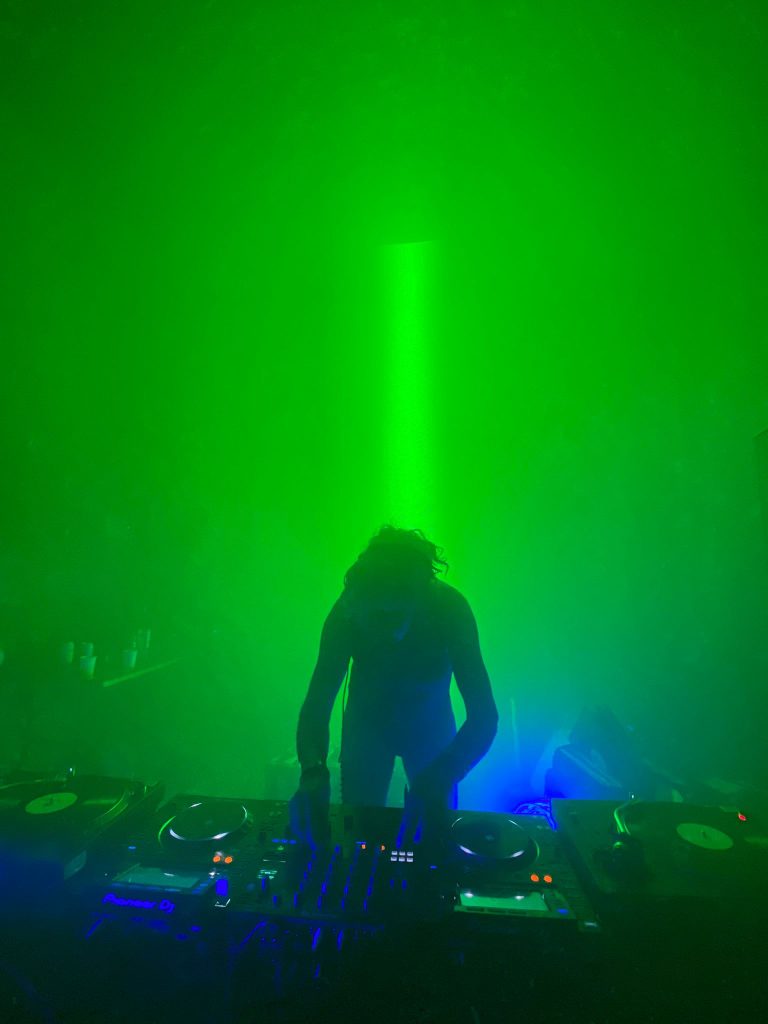
After speaking with Zaron in more depth, they revealed they suffer from Synaesthesia, which is defined as the blending of the senses—for example, ‘seeing’ shapes when listening to music. They offered their own perspective on their project (which if I haven’t made clear enough already, is mind blowing):
‘I find most people who have this sensation do not ‘suffer’ from it but I find for me it can be somewhat of a hindrance in communication. This is what inspired the original incarnation of this art installation back in 2017, a need to communicate an experience which can’t be explained with words. Comparisons to other similar experiences are probably the easiest way to relate to somebody what the installation is like because the experience is the result of a combination of internal sensory information it cannot be conveyed solely with words, it’s ineffable. I think it relates to the festival by offering a unique perspective on our own sensory experiences going through such an ordeal as the ‘British festival’, which can be a very overwhelming experience for many. This installation serves as a way to take a step back and observe how our mind can physically influence our body and vice versa.’
We open the door to the outside world and there is a flock of punters walking toward another magic door diagonally across from us. The doors have opened to the Love Hotel. Do I know what this means and why it’s open at 17:00 and not 22:00 as promised? No. Do I want to find out what’s inside? Absolutely.
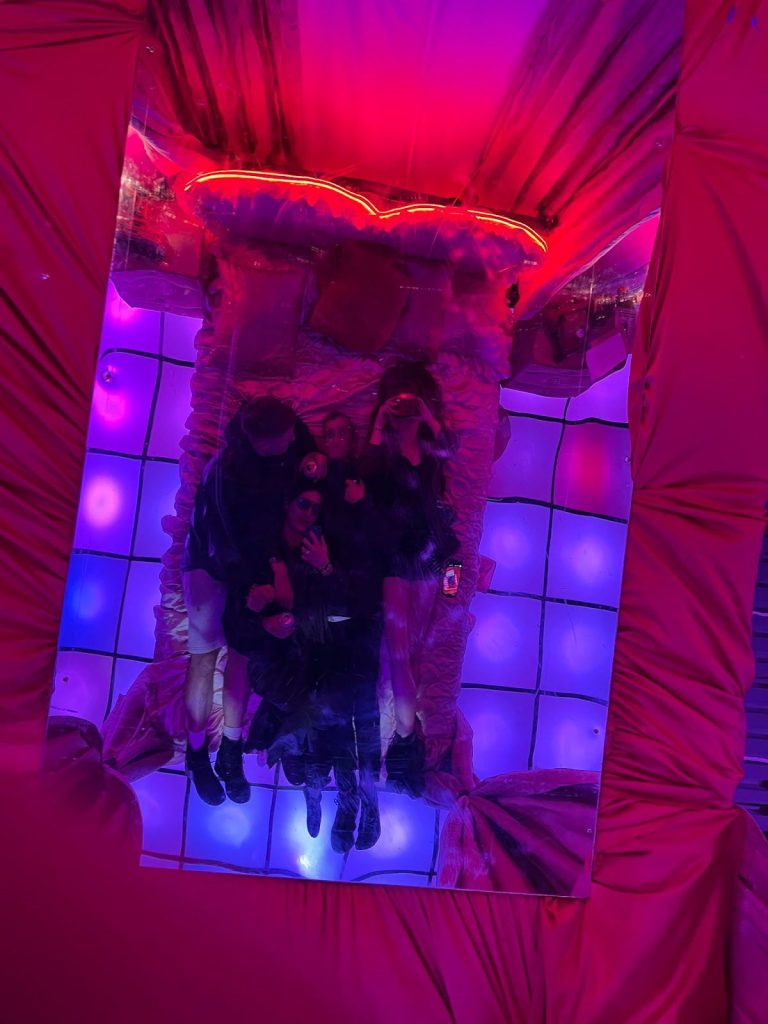
I thank Zaron for the experience and make my way with the herd. My senses are exploding; this is everything I would imagine my dream room to be… if I was persistently high on acid or addicted to sex. The floor is tiled in pink, purple and red lights, with a four poster bed in the centre of the room, with distorted mirrors as backdrops, and let’s not forget the disco balls hanging overhead. Whoever designed this, had a vision and left no detail unthought of. I’m so drawn in I don’t even pay attention to the DJ starting up the set behind me, drawing Kallidans from the rain and mainstage into the room. The energy rises and everyone is instantly one with the music, the walls, each other. I’m so glad I came!
After the festival I went looking for the mastermind behind the Love Hotel and came across Fiona Albrow, Art Director at Kallida. I was so intrigued as to what inspired this stage. She shared with me that their first venue had been used for swingers parties, ‘so the seed was probably sewn when she walked into one of the bedrooms and saw the carpeted steps to the hot tub and mirrors shaped like nude figures. She wanted to create a space in the festival for people to roll around on a bed and be silly in neon lights, shades of red and pink satin. The mood is David Lynch motels, seedy Japanese pay by the hour hotels and 90’s Beverly Hills girls’ bedrooms. The Love Hotel was conceived in contrast to the stark, minimalist club environments we usually rave in. This year, as the festival has grown, it became its own stage with a light up dance floor and music programmed to suit the aesthetic of the space.’
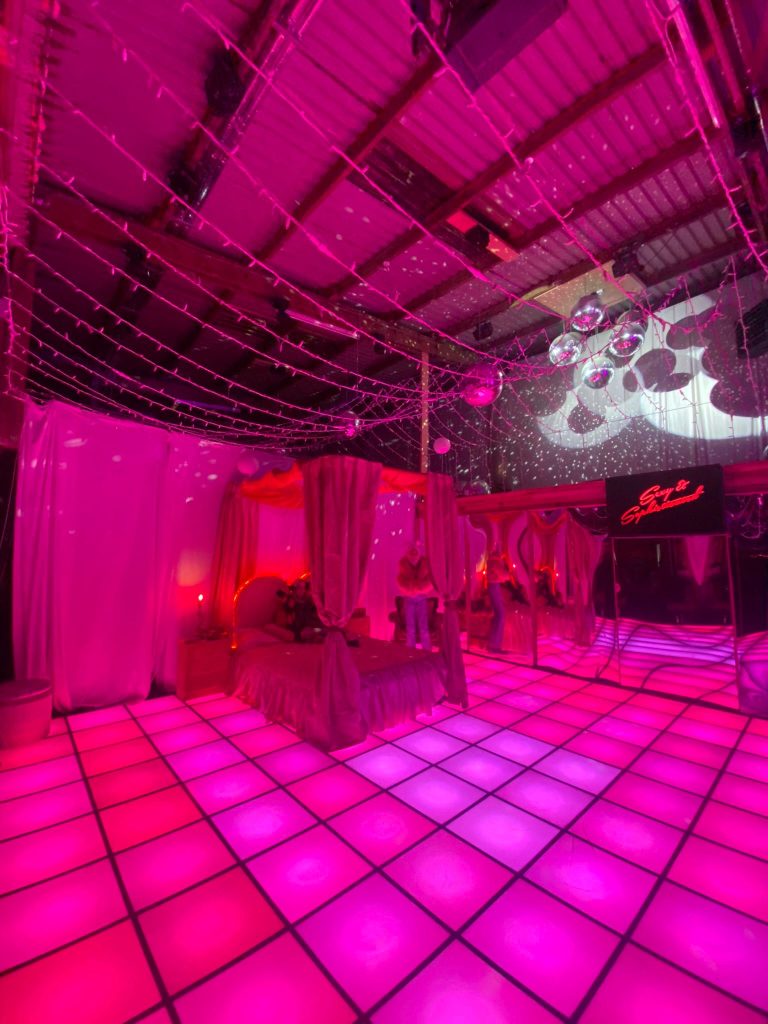
Back to the festival and our aimless frolicking through the grounds of Ash Barton State.
The night starts to fall and we all welcome the darkness, knowing and expecting 10 o’clock with excitement. I’m personally waiting to jump straight into 11PM and get moving with Mella Dee, in high hopes he plays ‘Techno Disco Tool’—a tune that’s gotten me through the highs and lows of this summer. We head to the Threshing Barn, and I can hear all around me people asking… What does ‘threshing’ mean? Well I’ve done the research for you and there’s two definitions: a) separating the grain from the crop typically with a flail or by the action of a revolving mechanism, and b) move violently; thrash. Both seemed fitting, but I’ll leave that to your interpretation. The stage is eye-catching, that’s for sure – it has everything you want to look at when you’re dancing; there’s plants, blocks of hay (fitting), roman head sculptures, and flashing blue, purple and red lights all contained by a wire fence that creates a necessary contrast to all the organic shapes and forms. As expected, Mella Dee DELIVERS but it was when DJ Priya was playing that I first noticed the lights flashing to the rhythms of his tracks – the Kallida team, and light designer Lee Samsons have done it again!
Later into the night, we venture into The Chapel, which attracts the darker of the lot into its deep drops and throbbing low end pulses of hefty sound system beats. The music spanned from dancehall, garage and Sheffield bassline, so as a more of a disco-trance girl myself, I was hesitant to go in earlier on, but now I felt ready – maybe I’ll change my mind? The door was so narrow it did feel like a weird commitment to danger. All you could see from the outside was a steady blue light and faint smoke (adjective to say like creeping out from inside). That’s when it clicked. The Chapel—the lighting and smoke was so simple yet so well thought out it felt almost religious. It was the only stage where you couldn’t make out the faces of the DJs, the only stage filled with a misty smoke, and because of that it was the only stage where you could truly devote your body to the music, unseen and completely surrendered.
The night comes to an end and I feel elevated and aching for my deliciously uncomfortable and laughably thin ‘mattress’. As we walk back to our tent, we notice the stars have come out.. You know what this means? Clear skies tomorrow! I swiftly close my eyes and I’m out.
I’m awakened by a sticky sensation of trapped heat. The sun is out, the birds are chirping, my back hurts and I can’t feel my arm from my already thin mattress that had completely deflated overnight, leaving me basically sleeping on solid ground. But it doesn’t matter, it’s warm and the sun is shining. After shoving a dry bread with cheese and ham and drinking a terrible instant coffee that tastes more like soil than actual coffee, I make my way to the walled garden which has come alive under the blue skies. A group of early risers were starting the yoga class next to an installation I hadn’t given the attention it deserved! A wall of textiles arranged in a geometric formation cast dramatic shadows over what would’ve been a large open garden. I get closer to immerse myself in the textiles and look at the patterns up close. Like many of the other installations and stages, the dominating colours are blue, purple, and red—a lucky coincidence? perhaps. The textiles carry prints with words, collages of photos to produce a strong Y2K aesthetic.
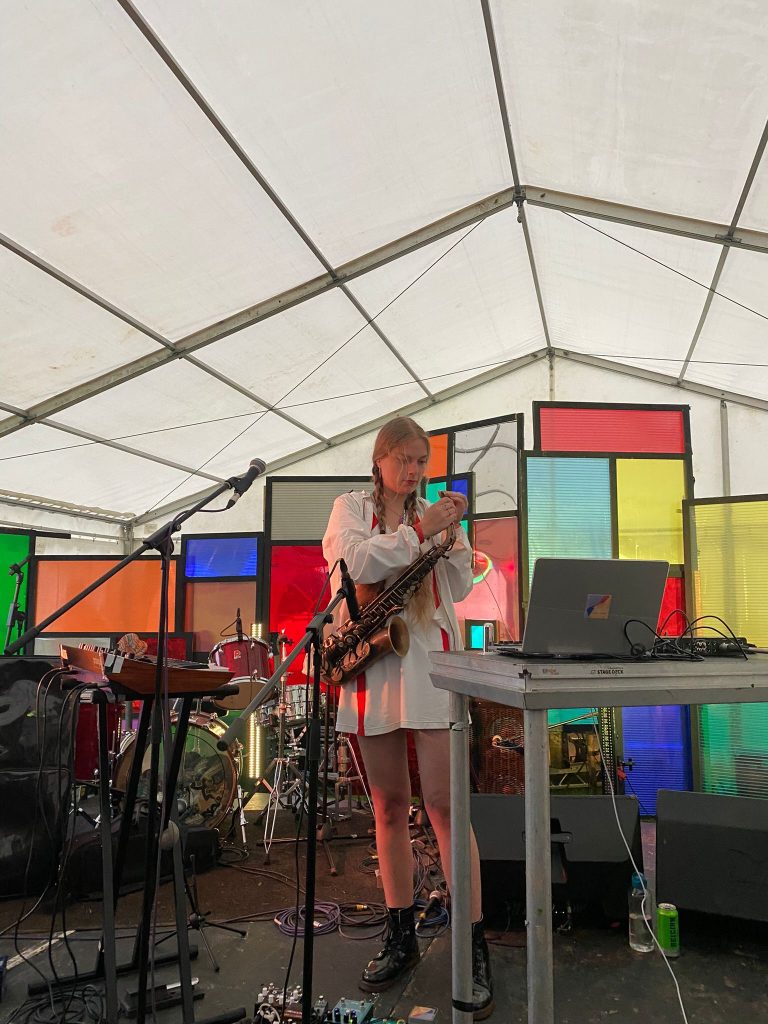
I later came to discover that this piece was in its second location, designed by artist Deen Atger, who’s also been a part of the festival from the start. ‘He designed this sculpture after his collective Disturbance got commission by Rally Festival in London. Disturbance is a trans-led program of residencies, workshops, talks and web network that aims to elevate LGBTQIA+ voices in the arts by creating a platform and a safe space for experimentation and innovation across digital and physical performances.
Habitually the artists’ work involves live projections and interactive live streams, but were pushed to think outside the box to adapt to Rally being a daytime event, a fitting material exploration to bring to Kallida this year too.
‘The piece comes from the desire to make a sculpture honouring trans artists in performance and electronic music, a shrine to the ones we lost but also a celebration of the joy we create for ourselves and others. It was also designed as a visual playground, a maze to honour trans artists and folks who have to go through a complex system of intricate bureaucratie as complicated as the maze.’
Anya Palamartschuk, Elodie Gatacre, Deen Atger
After speaking with Deen and reflecting that, as he very well put it, ‘music festivals can be so much more than just a place where people go to dance. They can be, when well designed and thought to, a true place of coming together. Intergenerational places of exchange, discovery, inspiration and self actualization’, I hope this piece can be taken into subsequent spaces and festivals across the UK where it can speak to its intended audience and generate the same feelings it evoked in our fellow Kallida attendees.
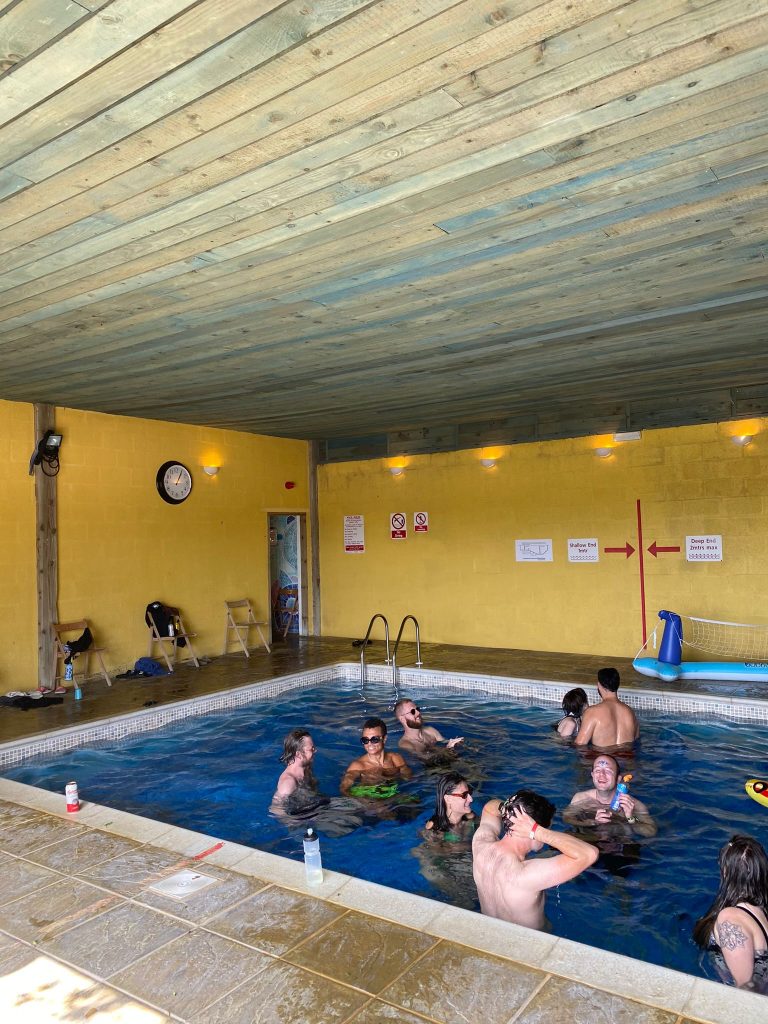
The rest of the day was mostly spent between karaoke, the pool, the Healing Fields listening to the most iconic meditation mantras… you wake up, there is £5,000 in your bank account, your phone is fully charged, you have a hot coffee… and mostly laying under the sunshine by the main stage. I want to make a special mention of how coincidentally Yama Warashi, one of my favourite artists that I discovered on a night out in Cafe OTO in Dalston, was wearing a dress that blended into the geometric stage, suggestive of Piet Mondrian. It really emphasised the unity and circularity of the festival; how everything by conscious thought or coincidence tied in together perfectly.
When the second night came around, everyone knew everyone and it really felt like one big house party with top tier sound system and surrealist stages yes, but a house party nonetheless. I kept bouncing between all three stages, not quite wanting to leave but eager to listen to the rest of the line up and discover how the night was developing in the other microcosms. In the little breaks I took, I came across two final installations that had caught my eye in the daylight but that really drew you in at night. The first was almost entirely hidden if you didn’t actively go looking for it. Also in the walled garden, I came across what looked a lot like a shrine, with candles, red velvety curtains and a really large collage backdrop in homage to none other than the one and only, Tina Turner. I had seen it by day but it had completely transformed by night, with the candles lit up, creating a sombre ambiance, and where a group of 3-4 friends had squeezed in to share comments of the night, smoke fags, and cuddle up unintentionally next to each other on the decorated floor. I almost considered asking if they had space for one more, but felt the intimate affair was plenty for Tina.
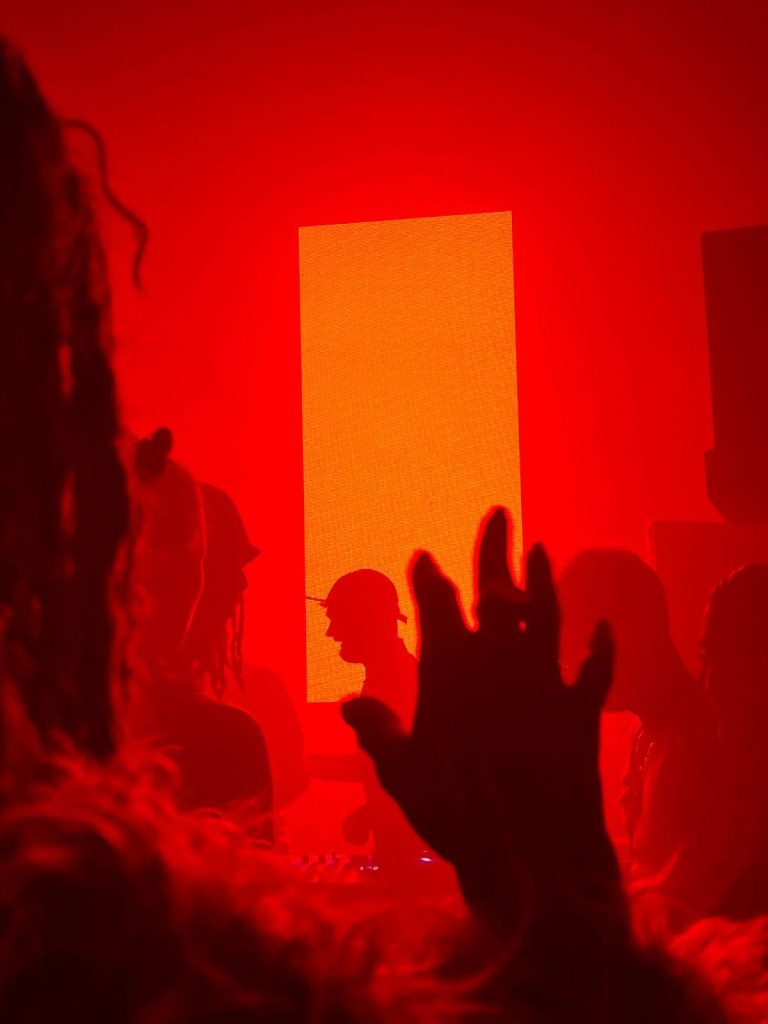
I continued the path down into the little pond at the bottom of the land, just in front of a giant willow tree with a double seated swing, that I chose as my spot for the following moments of my soon-to-be-morning night. Straight across from where I sat, rainbow reflections stared me in the face. I jumped off the swing and approached these moving colours attached to the roof of a small wooden structure. As I tilted my head backwards in a 90-degree angle, I was perplexed by what I was looking at. A circular structure made of Dichroic glass with a ladder-like form in the middle surrounded by four concave pieces around the diameter of the circle produced a combination of light and colours that was mesmerising. Think of a CD when you move it under a light, combined with the old moving screensavers of iMacs. Conor, the artist, explains his piece in such depth and beauty that I have no other choice but to share everything he said verbatim:
My primary ambition is to create a global movement to protect nature, through the medium of art. Dichroic glass has the capacity to consistently shift my emotional state to feelings of inspiration, euphoria, healing, meditation and beauty, the same emotions I receive outside, when immersed in nature. The power of this material and its qualities give me purpose. It makes sense for me to curate the same experiences for others, experiences that are so rare in urban environments, in which our drive for growth and profit create such busy lives that are prevented from being interdependent and one with nature. I think we forget that the drivers behind many decisions—ease, convenience and efficiency, are not in nature’s best interest. By emulating nature’s beauty, integrity and healing qualities through the medium of art, I aim to draw people’s attention to restoring and protecting it.
This work will take many forms and for Kallida I proposed a mindful piece that begins to explore the synergy between analogue visuals and electronic music. I wanted to immerse the audience into meditative states in order to contrast with the surrounding intensity of the weekend, as balance, in life, is key. I knew that my previous tests were capable of achieving this. To enhance the installation, I curated a 3 hour mix with songs selected for their meticulous sound design, ethereal qualities and capacity to create deep and reflective soundscapes. A span of genres was chosen in order to surprise the audience and transport them into a range of emotional states in which they could discover thoughts both old and new. The intention was that by heightening the sensorial stimulation, it would create a synergy that would make the experience more memorable and effective. My work is defined by detail.
Music is a form of art that has allowed me to travel to places previously unexplored in my mind. I have been invested in the electronic music scene for many years and alongside all the euphoric experiences, it has evolved my personal progression, relationships, motivation, self-belief and general enjoyment of life. It therefore makes sense for me to curate these club experiences to give back to the community which has provided so much. My installation for Kallida was just the start.
My work will extend beyond electronic music too, for people less involved in the scene and I intend for it to be integrated into both urban and natural environments.’
Elevated by the feedback from his art installation for Kallida festival, metic. recorded a mix to pair alongside this editorial article covering the installations at Kallida and the artists’ vision behind them:
This felt like a strong finish to my night and the most serendipitous closing to the phenomenal weekend that took me on a ride. From stormy wet tents, to brits in the wild singing along to Queen’s ‘Don’t Stop Me Now’ amongst other all time pub-classics, and transportational DJ sets, we lived it all. Kallida left us feeling ecstatic, moved and terribly heartbroken to leave. We can hardly wait to see what you got in store for us in 2024.
FIONA

1. How did you find Kallida or how did they reach out to you?
I’ve been involved with Kallida from its inception as the Art Director. The first year we ran, Lee Sampson, our Lighting Designer and I talked about creating a sensuous immersive installation which would express the character of the festival. As much as the sound and music is at the forefront at Kallida, so are the aesthetics. I’m interested in how the physical space effects how people party. I want the environment to be inviting and liberating.
2. What inspired the space design / what was the concept behind it and how does it relate to the festival /music?
Our first venue had been used for swingers parties so the seed was probably sewn when I walked into one of the bedrooms and saw the carpeted steps to the hot tub and mirrors shaped like nude figures. I wanted to create a space in the festival for people to roll around on a bed and be silly in neon lights, shades of red and pink satin. The mood is David Lynch motels, seedy Japanese pay by the hour hotels and 90’s Beverly Hills girls’ bedrooms. The Love Hotel was conceived in contrast to the stark, minimalist club environments we usually rave in. This year, as the festival has grown, it became its own stage with a light up dance floor and music programmed to suit the aesthetic of the space.
3. Are you looking to develop this further or take the installation to other spaces?
Yes, I think it has multiple paths it suits. As an installation space we had other artists exhibit inside the room with video art or screens and sound art on the red dial phone. It would be interesting to explore working on the theme with new artists and collaborators.
I can also imagine The Love Hotel continuing as a dance stage as it has such a strong aesthetic and people respond really well to the vibe it creates. Yes, I think it has multiple paths it suits. As an installation I worked with our Art Instillation lead, Deen Atger to populate the space with other artists displaying video art or screens and sound art on the red dial phone. It would be interesting to explore working in the theme with new artists and collaborators. I can also imagine The Love Hotel continuing as a dance stage as it has such a strong aesthetic and people respond really well to the vibe it creates.
4. How did you find people interacted with Love Hotel? Any interesting reactions?
I think it’s always been a fun surprise to encounter. Before it was a stage it had the feeling of wandering into a cheeky bedroom; now there is a four poster bed on the dance floor with a mirror suspended above it. People love taking photos there, hanging off the bed frame, lying on the bed. Its definitely seen a lot of action over the years!
5. Particularly anything that left an impression or surprised you?
It’s always amazing to be reminded of how much effort goes into the festival. I think we have been incredibly lucky to have so many creative collaborators in our friends and festival goers. It’s been inspiring to see how a collection of people can become a sum greater than their parts. All for 2 days of dancing!
It’s always humbling to be reminded of how much effort goes into the festival. I think we have been incredibly lucky to have so many creative collaborators in our friends and festival goers, involved in co-creating the festival. Reg Manning, Freddy Hardie, Vito Walker, Thea Von-Mantrip and Miriam Griffith are all amazing artists who have been involved almost every year from the beginning. It’s been inspiring to see how a collection of people can become a sum greater than their parts. All for 2 days of dancing!
Fiona Albrow
Art Director
FREDDY

1. I’ve been involved with Kallida since the beginning. I’ve previously been involved with working with the organisers on various projects. I’m a textile artist so the ethos of Kallida using art and music was perfect for me to get involved in. I think so many festivals have their main emphasis on music and DJs that often the aesthetic is forgotten.
2. In previous years we produced the amazing seating at the main stage using carefully picked out fabrics and colour palette, chosen by Fiona Albrow. I worked closely with Fiona to produce a lot of textiles and parts of the festival. We used fabric to create a variety of spaces. The art work I produced this year is a reflection on all of the Festival. There’s also an amazing piece at the back of the main stage built with acetate colours which was built by Reg Manning and again concept with fiona. I wanted the fabric to mimic this design and colours. So basically the piece is an illustration of the festival over the years.
3. I’d love to develop this idea of creating pieces that illustrate the themes of festivals.
4. I’ve not really received much individual feedback, but as a whole I think people love the ideas and thought that go into the Kallida festival.
5. Kallida festival always surprises me, how this amazing collective of people manage to keep coming up with new artwork, lighting and sounds is incredible. I particularly loved the combination of Lee Samsons lighting in the chapel and the DJ proteus industrial sound this year. This combo was perfect and something I’ve never seen done so well. I feel like as they both have their roots in Sheffield this really comes across. Being from Sheffield myself and now living in London I can see the way this really is apparent throughout the festival. With also the amazing music and sounds and influences of the festival in Uganda (I need to look up the name).
CONOR
1. How did you find Kallida or how did they reach out to you?
I first knew about Kallida after my final year product design exhibition in July 2022. I had a conversation with my tutor, Andrew, about dance music and Dj-ing, which is when I found out that his friends ran the festival. This knowledge became dormant until after my debut installation at Above Below, Ivinghoe, in June 2023. I caught up with Andrew and logically enquired if Kallida could exhibit my second installation and so he put the wheels in motion with the organisers, which came back positively. After a
a busy summer, a short proposal and a few test examples later, 18 days before the festival, they confirmed they would like the installation. The challenge had begun.
2. What inspired your design / what was the concept behind it and how does it relate to the festival /music?
My primary ambition is to create a global movement to protect nature, through the medium of art. Dichroic glass has the capacity to consistently shift my emotional state to feelings of inspiration, euphoria, healing, meditation and beauty, the same emotions I receive outside, when immersed in nature. The power of this material and its qualities give me purpose. It makes sense for me to curate the same experiences for others, experiences that are so rare in urban environments, in which our drive for growth and profit create such busy lives that were prevented from being interdependent and one with nature. I think we forget that the drivers behind many decisions—ease, convenience and efficiency, are not in nature’s best interest.
By emulating nature’s beauty, integrity and healing qualities through the medium of art, I aim to draw people’s attention to restoring and protecting it.
This work will take many forms and for Kallida I proposed a mindful piece that begins to explore the synergy between analogue visuals and electronic music. I wanted to immerse the audience into meditative states in order to contrast with the surrounding intensity of the weekend, as balance, in life, is key. I knew that my previous tests were capable of achieving this. To enhance the installation, I curated a 3 hour mix with songs selected for their meticulous sound design, ethereal qualities and capacity to create deep and reflective soundscapes. A span of genres was chosen in order to surprise the audience and transport them into a range of emotional states in which they could discover thoughts both old and new. The intention was that by heightening the sensorial stimulation, it would create a synergy that would make the experience more memorable and effective. My work is defined by detail.
Music is a form of art that has allowed me to travel to places previously unexplored in my mind. I have been invested in the electronic music scene for many years and alongside all the euphoric experiences, it has evolved my personal progression, relationships, motivation, self-belief and general enjoyment of life. It therefore makes sense for me to curate these club experiences to give back to the community which has provided so much. My installation for Kallida was just the start.
My work will extend beyond electronic music too, for people less involved in the scene and I intend for it to be integrated into both urban and natural environments.
3. Are you looking to develop this further or take the installation to other spaces?
I’m open to taking it to other spaces to generate more conversations and observe interesting interactions and ideas. This is always valuable for the creative process. There are further elements I can add to the current installation to create a more immersive experience and I can also diversify the accompanying music to test the boundaries of what’s possible—I have a lot of songs and ideas to play with.
However, I am cautious of allowing the work to grow before it and I am ready. In order for my work to truly channel what nature intends, there are various tasks I now know I must resolve in order to create the foundations for this work to evolve from and ensure it maintains Integrity.
I am working on Kallidascope 2.0 which will provide an experience of beauty like no other. It will certainly take me more than 18 days but I’m confident that it will hold a power capable of inspiring people and reconnecting them with where we’ve come from. It will feature in a documentary that I am creating with my brother that encompasses everything in this article and hopefully serves as inspiration for others.
4. How did you find people interacting with the installation?
Any interesting reactions? Some people shared that it allowed them to explore childhood memories with their friends and stimulate nostalgic thoughts. This was very significant for me to hear as it was my intention for it to achieve such things. Others got lost for 40 minutes without getting up, and groups of people, who had previously not met, came to experience the installation together and look up in awe. People would vocalise their present thoughts at different times and share a myriad of shapes, colours and illusions that they could see—mesmerisation was a key experience for many. But what was most powerful were the prolonged moments of silence as I believe this is a true indication of comfort in your surroundings, your ephemeral headspace and with the people around you. It was very special to me to be able to provide that experience of contentment for people, and the beanbags certainly helped.
I am innately attracted to the ethereal qualities of our environment and the works of other creatives, from sounds to materials, colours, gradients, or light play. I think that these otherworldly characteristics hold an element of ambiguity which allow people to explore these spaces with their own thoughts. As everyone is built from different contexts and influences from their upbringing, it means that these ambiguous explorations are unique to each person. By providing a context for people to enter these reflective states, I believe it allows them to pause, relax, contemplate and act as a form of therapy for people to personally nurture their well-being. Such context is rare for many people, but I have experienced first hand that it is so powerful to be able to pause, reflect, breathe and then do, rather than just do.
I think that our busy lives can shift what we perceive to deserve our attention and it’s only when invited into these contemplative states that we are able to analyse our roles and the consequences of our actions. Upon this reflection and circular process, I believe we can shift our focus to opportunities and acts that are more beneficial for the planet. Often this is not the most convenient option but perhaps a more intelligent one as a whole. I intend to create communal spaces for people so they can feel more responsible for and in control of their emotional states and actions. I want people to believe in their capacity to act in the ways necessary to achieve their own goals and also participate in initiatives that aim to restore life on earth. I hope that these spaces of reflection will allow them to realise their passions, inspirations, people and other organisms of significance, how important they are to many and what role they play, or can play, in and amongst our natural environment. If people can identify these elements for themselves, I believe it creates a strong foundation for them to help others and create communities of people who work symbiotically and feel like they have purpose.
5. Particularly anything that left an impression or surprised you?
The gatherings of people that it brought together was the most inspiring observation for me. Music has the capacity to achieve this on its own, but it is sometimes difficult to converse when in the dance. I noticed that the installation in its current form could do both. I love the idea that my work can create connections between people that previously didn’t exist. Collaboration is the key to creating new ideas and establishing movements and local communities that can equally add value to both society and nature. I think that when people understand that they can achieve goals by sharing what they enjoy or what they’re good at, rather than being distracted by monetary transactions, there’s a sense of harmony, altruism, unity, compassion and empathy that is created and shared, which perpetually motivates the cycle.
Local communities can solely exist when people share their skills and give each and everyone a purpose, no matter how big or small. When people come together to accomplish values, a powerful synergy is created. The whole is now greater than the sum of its parts. This is what’s necessary to create the movement required to make a difference to restore Mother Earth and for it to thrive again.
#alwaystakecareofthedetails
https://www.instagram.com/art_metic/
DEENO
1. How long have you been working with Kallida – how did you manage the art installations or find artists?
I’ve been involved in Kallida since the very beginning actually, I was brought to the team by my dear friend Fiona Albrow who was and still is doing the whole art direction of the festival. My role was to find cool artists for them to take part in the festival with art installations, mainly via my work as curator at Ugly Duck. I would find artists fitting our vibe and vision but also some people would get in touch with the desire of bringing their recent creation.
We mainly focused on digital and electronic culture for the music as well as for the art meaning that we worked with light artists working on sculptures, video artists and projection mapping. It’s pretty amazing that some of them now have quite big names, Aphra Shemza for example or Billy Fraser or the designer collective Kai Lab. Kallida is very artist led so the core crew are also artists Lee Lee samson and Pete Dunsby. Are truly visionaries.
2. What inspired your art installation / what was the concept behind it and how does it relate to the festival /music?
It’s a piece that I did after my collective @Disturbance got commission by Rally Festival in London to make an artwork. @Disturbance is a trans-led program that aims to elevate LGBTQIA+ voices in the arts by creating a platform and a safe space for experimentation and innovation across digital and physical performances. A yearly program of residencies, workshops, talks and a web network model where past artists return as juries, speakers and mentors.
So we habitually work with live projection and interactive live streams but as Rally was during the day we had to find something else. I thought about making a sculpture honouring trans artists in performance and electronic music, a shrine to the ones we lost but also a celebration of the joy we create for ourselves and others. So many innovations in terms of music or other arts are created by people who have transcended their own boundaries. The Sculpture was made of a wooden scaffolding with a large piece of fabric printed with a digital collage of some poetry and images. It was also designed as a visual playground, a maze to honour trans artists and folks who have to go through a complex system of intricate bureaucratie as complicated as the maze.
Installation by Disturbance:
Anya Palamartschuk , Elodie Gatacre, Deen Atger
3. Are you looking to develop this further or take the installation to other spaces?
Yes I would love to show it at other spaces, weirdly even though it works more in contemporary art, music festivals have been really cool places to show this work.
We’re also looking at getting more commission to create other pieces and as I said in March we’ll be putting on our live show—you’ll have to come for that!
4. How did you find people who interacted with your project? Any interesting reactions?
It’s been wonderful to see people interact with it. Yes, many were really so interested, emotional, paying a lot of attention even late in the day or night when obviously being a bit more merry. It was wonderful to see people getting the sort of message or intention we were trying to share with them at the very first brainstorming of the build of the piece. I think the best reaction was that someone shared some tears but they were tears of joy as well as of grief.
5. Particularly anything that left an impression or surprised you?
Music festivals can be so much more than just a place where people go to dance. They can be, when well designed and thought to, a true place of coming together. Intergenerational places of exchange, discovery, inspiration and self actualization. I think everyone left Kallida this year feeling so ecstatic, many people told me they could really feel the care that our team put into this event, all truly out of passion and love for music and arts.
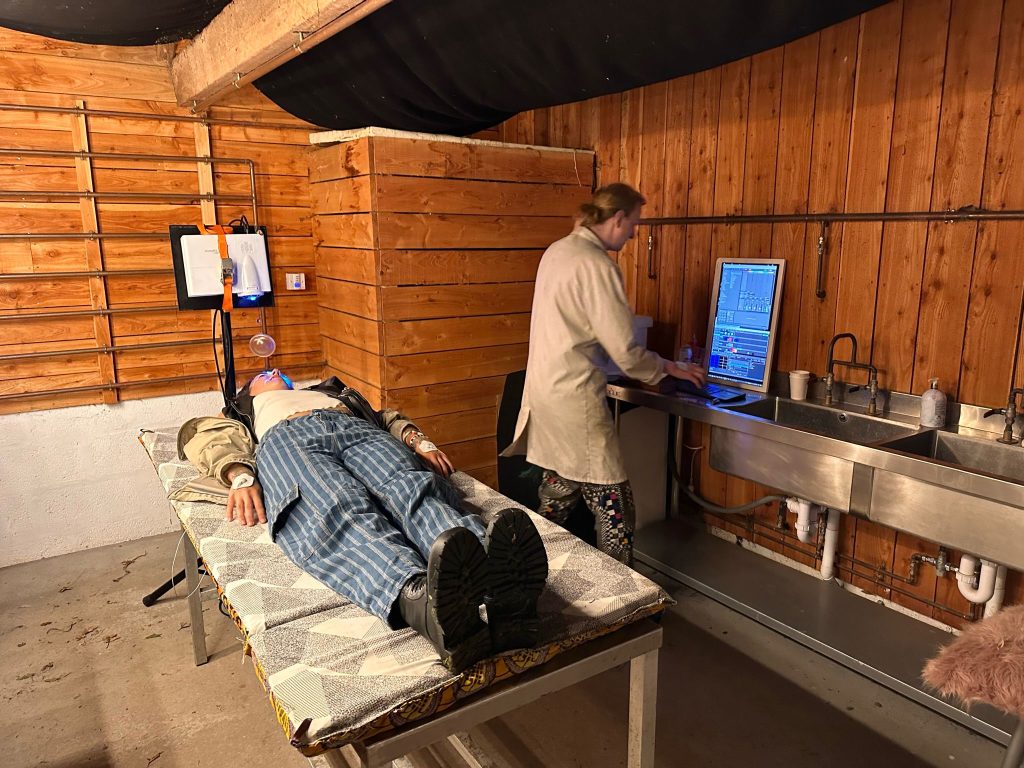
AARON
1. How did you find Kallida or how did they reach out to you?
I worked with Pete Dunsby (Funsby), one of the organisers, at various venues across Sheffield for many years. We worked on some fun projects together, this happens often with my work as a lighting designer but I especially appreciated what Pete was doing in terms of making & building diy lighting systems, as that is what I enjoy also. Furthermore, I am constantly talking about my art practice & the philosophy behind it so as soon as there is ever an opportunity to convey a message to people, in any capacity, I take it.
2. What inspired your art installation / what was the concept behind it and how does it relate to the festival /music?
I suffer from Synaesthesia, which is defined as the blending of the senses. I find most people who have this sensation do not ‘suffer’ from it but I find for me it can be somewhat of a hindrance in communication. This is what inspired the original incarnation of this art installation back in 2017, a need to communicate an experience which can’t be explained with words. Comparisons to other similar experiences are probably the easiest way to relate to somebody what the installation is like because the experience is the result of a combination of internal sensory information it cannot be conveyed solely with words, it’s ineffable. I think it relates to the festival by offering a unique perspective on our own sensory experiences going through such an ordeal as the ‘British festival’, which can be a very overwhelming experience for many. This installation serves as a way to take a step back and observe how our mind can physically influence our body and vice versa.
3. Are you looking to develop this further or take the installation to other spaces?
Yes definitely, I have been working on various versions of it on and off since its inception and hope to refine it further and make the experience even more dynamic and exciting! In the future I would like to make a 2-player version of it, where each are shown a biological state and the 1st/closest participant to reach that state ‘wins’ if that makes sense? I would also like to utilise many other non-invasive methods of externalising biological data, like eye-tracking.
4. How did you find people who interacted with your project? Any interesting reactions?
Because the installation responds based on how a person is feeling, everyone interacted with it completely independently, both actively and passively. Those who were anxious would have had and felt an anxious response from it, and inversely those who were more at ease will have had a calming experience. It exacerbates your feelings like that I find, whether you want it to or not!
Everyone reacted so differently, it was very exciting to see because I had made the installation according to how I felt, to then to see it react completely differently with a new set of sounds and colours for each person was incredibly heart-warming. Only 1 or 2 people had a bad experience with it, which considering I estimated putting around 100 people through is an acceptable rate of failure.
5. Particularly anything that left an impression or surprised you?
I put someone in the installation that also had synaesthesia and they had a very interesting reaction that was almost exclusively colours and all of them too! Seeing my work be accessible and communicable with other synaesthetes is an intensely great joy to me.
Recently, I woke up in the midst of an intense panic attack, 100% convinced I was on the very brink of death. So I reasoned that if I was going to die I at least wanted it to at least sound good, so I instantly whipped out ableton and connected the circuit (that I use for this installation) that detects micro-changes in the skin (Galvanic Skin Response) and translates them into MIDI notes. I did a quick bit of sound design and off I slipped into what I was then convinced was death. I, of course awoke the next day to the mellifluous tones of reality, however it was the ability of using this interactive work to quantitatively record how I was feeling at that exact moment in time that struck me when I listened back to it. Since then I have been recording my biology whilst asleep every day/night and I intend to use these datasets for both training and creating further works. I think everyone has different ways of dealing with stress and anxiety especially regarding death; I cope best by making things. It alleviates a part of me that doesn’t want to be forgotten, ideas can outlive people by a long shot.
by Morena Alano
Editor: Alex H Honey






